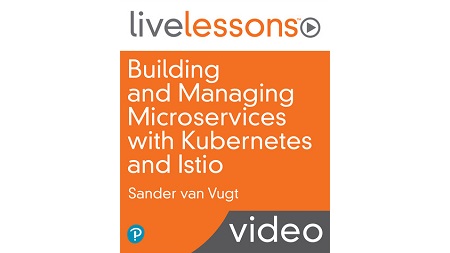
English | MP4 | AVC 1280×720 | AAC 48KHz 2ch | 74 Lessons (6h 14m) | 5.54 GB
Learn the most efficient way to manage and run Microservices in Kubernetes and Istio.
Microservices are the new development model for running complex applications. Building and Managing Microservices with Kubernetes and Istio LiveLessons will cover the topics you will need to run successful Microservices in Kubernetes and Istio.
Building and Managing Microservices with Kubernetes and Istio LiveLessons starts with an overview of Microservices and why it is the right choice to run complex applications. The course will then discuss how to automatically implement Microservices using Kubernetes, a procedure that starts with source files in Git, before exploring topics of container images and how to build them efficiently. Lastly, it will also cover how to apply decoupling in Kubernetes for full implementation of automated and orchestrated Microservice environment.
Instructor Sander van Vugt uses hands-on-labs to give you a deeper understanding of the topics covered in the course.
Topics include:
- Understanding Microservices
- Using Git
- Containers QuickStart
- Understanding Container Orchestration and Service Mesh
- Getting Started with Kubernetes
- Creating Container-based Microservices in Kubernetes
- Getting Started with Istio Service Mesh
- Managing Microservices with Istio Service Mesh
Learn How To
- Manage source code for microservices
- Build custom container images
- Use Kubernetes technology to manage Microservices
- Use Service Mesh
Table of Contents
1 Building and Managing Microservices with Kubernetes and Istio – Introduction
2 Learning objectives
3 What are Microservices
4 Microservices and Containers – A Perfect Match
5 From Monolithic Application to Microservice
6 The Role of 12-Factor Apps in Microservices
7 DevOps and Microservices
8 Understanding the Goals of this Course
9 Introducing the Course Microservice Project
10 Learning objectives
11 Understanding Git in a Microservices Environment
12 Understanding Git
13 Setting up a Git Repository
14 Using Git Repositories
15 Working with Branches
16 Lesson 2 Lab – Setting up a Github Repository
17 Lesson 2 Lab Solution – Setting up a Github Repository
18 Learning objectives
19 Understanding Containers
20 From Images to Running Containers
21 Using Container Registries
22 Using Containers
23 Using Webhooks to Automatically Trigger New Container Image Builds
24 Lesson 3 Lab – Using Containers
25 Lesson 3 Lab Solution – Using Containers
26 Learning objectives
27 Why Orchestration is Needed
28 Understanding Microservices Orchestration
29 Exploring Container Orchestration Solutions
30 Understanding Kubernetes
31 Understanding Service Mesh
32 Lesson 4 Lab Planning for an Orchestrated Architecture
33 Lesson 4 Lab Solution Planning for an Orchestrated Architecture
34 Learning objectives
35 Using Kubernetes in Minikube
36 Using Kubernetes in Google Cloud
37 Installing All-in-One Kubernetes
38 Understanding Core Application Components in Kubernetes
39 Running Applications in Kubernetes
40 Understanding the Philosophy of Decoupling in a Microservices Context
41 Using the kubectl Utility in Declarative or Imperative Mode
42 Understanding the Kubernetes API
43 Troubleshooting Kubernetes Applications
44 Lesson 5 Lab – Running the Course Project in Kubernetes Deployments
45 Lesson 5 Lab Solution – Running the Course Project in Kubernetes Deployments
46 Learning objectives
47 Feeding Images into Kubernetes
48 Organizing Pod Storage
49 Using Storage Provisioners
50 Providing Flexible Parameters Using ConfigMaps and Secrets
51 Exposing Applications Using Service Objects
52 Providing Fixed DNS URLs Using Ingress
53 Using Kustomize.yaml
54 Using Canary Deployments in Kubernetes
55 Lesson 6 Lab Implementing the Course Project as a Full Microservice on Kubernetes
56 Lesson 6 Lab Solution Implementing the Course Project as a Full Microservice on Kubernetes
57 Learning objectives
58 Understanding What a Service Mesh is Used for
59 Understanding Istio
60 Setting up Istio
61 Running the Bookinfo Demo Application
62 Using the Dashboard
63 Lesson 7 Lab Setting up Istio Service Mesh
64 Lesson 7 Lab Solution Setting up Istio Service Mesh
65 Learning objectives
66 Managing Traffic Flow with Istio
67 Using Istio for Fault Injection
68 Querying Metrics with Prometheus and Istio
69 Visualizing Metrics with Grafana and Istio
70 Using Istio to Access External Services
71 Managing the Course Sample Project with Istio
72 Lesson 8 Lab Running the Course Project in Istio
73 Lesson 8 Lab Solution Running the Course Project in Istio
74 Building and Managing Microservices with Kubernetes and Istio – Summary
Resolve the captcha to access the links!